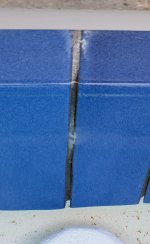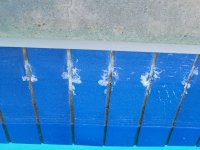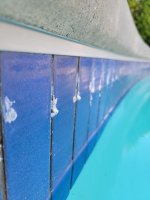Hi TFP! We've been long time readers of TFP and followed it guidance successfully over the years. We need your help!
Super short version: we have this white substance (see pictures) is that growing on our tiles (both above the water line and below). It is definitely not calcium deposits (it's soft and it grows in 24 hours). Using our trusty Taylor water kit we super shocked the pool with a FC level of 28 for 3 days...and it still didn't kill the growth. Wow. Now we have no idea what to do. Has anyone encountered this before? How did you get rid of it? If we call in pros to help, what should they have experience with?
----
Longer tale of woe
Stats: Our in-ground pool is ~18.5k gallons. Plaster surface redone more than 5 years ago, but less than 10. Connected to a Pentair cartridge filter. We also have solar roof panels for warming the water.
Maintenance: We're DIYers based on the great guidance here (we can't use hotel pools anymore now that we know how clear pool water is supposed to look!). We try our best to keep FC between 3-7, pH between 7.2-7.6, and Alkalinity between 80-100. The most recent test reading showed Calcium at 500, Alkalinity at 80, CYA at around 30, and phosphate at around 100 . We track CSI and all the like using our Taylor test kit. We use liquid chlorine (to keep the CYA levels from rising too much) and acid to balance the water, and also use Algaecide, PhosFREE, and Alkalnity UP (from Leslie's Pool Supply) as needed .
What happened
Back a few weeks ago our auto-fill valve got stuck. The water leveler thought it was off, but the value itself got jammed. We only realized this after my daughter saw water spilling over the edge of the pool. We shut the water off, fixed the value, and thought we were good.
But then we noticed this odd little white growth that was growing in the grout between two of the tiles. See picture 1. This picture was taken after we had used a wire brush to clean the grout and even poured liquid chlorine right near that part of the pool. Prior that cleaning the white growth was 10x that size (somewhat similar to the size of a Chapstick). Despite that cleaning and treatment in 24 hours it grew back to the size shown in image 1.
At this point we read about "white algae" online and jumped into action. We put the FC at 28 for 3 days thinking that would kill it. Nope! It still grew, much more slowly, but it grew. The FC level was only dropping by 1 overnight and we never saw floating things in the water that looked like tissue paper, so we thought perhaps it's not white algae, but maybe kind of mold/fungus. The only solace we took was that the growth seemed limited to that one tile area.
Based on that guess we decided to shut off the water feed altogether and wait until the water level got below that troublesome spot in the tile. I purchased an organic fungicide and a hospital level "it kills everything" cleaner to attack the growth once the water level was low enough. The water dropped low enough today, so I went out...and saw pictures 2 and 3. It now appears like that growth is now happening above the water line, and around the entire pool (nooooo!), and seems quite happy to have embedded itself in our dark grout. Lord have mercy...
Extended questions
Given the amount of extended cleaning needed I'm guessing we need I'm very much leaning towards calling in paid professionals to take care of this. But I don't want someone coming in saying, "You just need to shock the pool!", do a cursory cleaning, shock the pool once, leave, and then for this to come back in 24 hours.
Has anyone ever seen something like this before? I have a feeling when the water overflowed the pool it must have drained something nasty from the concrete deck into the pool (whether that be fungus, mold, something from a bird dropping who knows what).
We're looking for a professional that not only will get rid of this issue, but someone who knows water safety enough so that whatever they do to get rid of the issue they don't leave the water in such a state that our teeth will fall out once we get back in the water. Of course if you TFP'ers know of a decent DIY solve for this please enlighten us!
Of course if you TFP'ers know of a decent DIY solve for this please enlighten us!
Help us TFP family!
Super short version: we have this white substance (see pictures) is that growing on our tiles (both above the water line and below). It is definitely not calcium deposits (it's soft and it grows in 24 hours). Using our trusty Taylor water kit we super shocked the pool with a FC level of 28 for 3 days...and it still didn't kill the growth. Wow. Now we have no idea what to do. Has anyone encountered this before? How did you get rid of it? If we call in pros to help, what should they have experience with?
----
Longer tale of woe
Stats: Our in-ground pool is ~18.5k gallons. Plaster surface redone more than 5 years ago, but less than 10. Connected to a Pentair cartridge filter. We also have solar roof panels for warming the water.
Maintenance: We're DIYers based on the great guidance here (we can't use hotel pools anymore now that we know how clear pool water is supposed to look!). We try our best to keep FC between 3-7, pH between 7.2-7.6, and Alkalinity between 80-100. The most recent test reading showed Calcium at 500, Alkalinity at 80, CYA at around 30, and phosphate at around 100 . We track CSI and all the like using our Taylor test kit. We use liquid chlorine (to keep the CYA levels from rising too much) and acid to balance the water, and also use Algaecide, PhosFREE, and Alkalnity UP (from Leslie's Pool Supply) as needed .
What happened
Back a few weeks ago our auto-fill valve got stuck. The water leveler thought it was off, but the value itself got jammed. We only realized this after my daughter saw water spilling over the edge of the pool. We shut the water off, fixed the value, and thought we were good.
But then we noticed this odd little white growth that was growing in the grout between two of the tiles. See picture 1. This picture was taken after we had used a wire brush to clean the grout and even poured liquid chlorine right near that part of the pool. Prior that cleaning the white growth was 10x that size (somewhat similar to the size of a Chapstick). Despite that cleaning and treatment in 24 hours it grew back to the size shown in image 1.
At this point we read about "white algae" online and jumped into action. We put the FC at 28 for 3 days thinking that would kill it. Nope! It still grew, much more slowly, but it grew. The FC level was only dropping by 1 overnight and we never saw floating things in the water that looked like tissue paper, so we thought perhaps it's not white algae, but maybe kind of mold/fungus. The only solace we took was that the growth seemed limited to that one tile area.
Based on that guess we decided to shut off the water feed altogether and wait until the water level got below that troublesome spot in the tile. I purchased an organic fungicide and a hospital level "it kills everything" cleaner to attack the growth once the water level was low enough. The water dropped low enough today, so I went out...and saw pictures 2 and 3. It now appears like that growth is now happening above the water line, and around the entire pool (nooooo!), and seems quite happy to have embedded itself in our dark grout. Lord have mercy...
Extended questions
Given the amount of extended cleaning needed I'm guessing we need I'm very much leaning towards calling in paid professionals to take care of this. But I don't want someone coming in saying, "You just need to shock the pool!", do a cursory cleaning, shock the pool once, leave, and then for this to come back in 24 hours.
Has anyone ever seen something like this before? I have a feeling when the water overflowed the pool it must have drained something nasty from the concrete deck into the pool (whether that be fungus, mold, something from a bird dropping who knows what).
We're looking for a professional that not only will get rid of this issue, but someone who knows water safety enough so that whatever they do to get rid of the issue they don't leave the water in such a state that our teeth will fall out once we get back in the water.
Help us TFP family!





